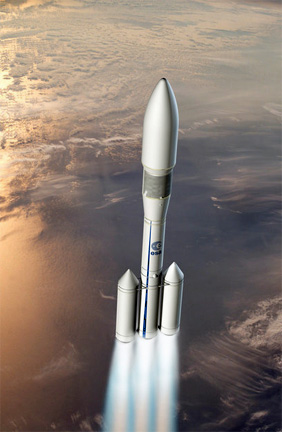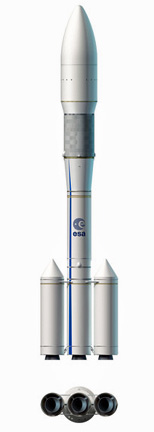
Artistic rendition of the Ariane 6, courtesy of ESA.
The performance requested for the new launch vehicle was 3–6.5 tons in equivalent geostationary transfer orbit (GTO), to cover governmental and commercial needs. The general configuration retained was ‘PPH’—indicating the sequence of stages using solid propulsion, solid propulsion and cryogenic propulsion. Ministers also requested that the new launch vehicle exploits maximum commonalities with the cryogenic reignitable upper stage of Ariane 5 ME.
Seven months after ESA’s Ministerial Council decision, the project team of ESA, supported by CNES, has endorsed the final concept proposed by industry for the vehicle that will become Europe’s workhorse for reaching space in the 2020s and beyond. This concept was selected after six months of trade-off studies done by a ‘plateau projet’ integrating industrial teams (Astrium, Avio, Herakles and the participation of Safran, MT Aerospace and others) working under ESA contract, consistent with Ministerial decisions mentioned above. The choice of configuration was made by consensus and based on the following main criteria: Exploitation costs, time to market and development costs.
Ariane 6 will benefit from the advances by European industry in solid and cryogenic propulsion, structures, systems, avionics, ground segment and operations through the Ariane and Vega programmes.

Artist's view of the 'Multi P linear' concept for the Ariane 6, courtesy of ESA.
The next step will be for ESA to consult with industry to gather competing ideas on key work packages of the new launch system. Industry will have maximum flexibility for meeting the requirements. Consolidation of the current Phase A will take place at the Preliminary Requirements Review (PRR) in October 2013. Decisions taken by the ESA Council at Ministerial level in November 2012 are being implemented strictly and timely.

